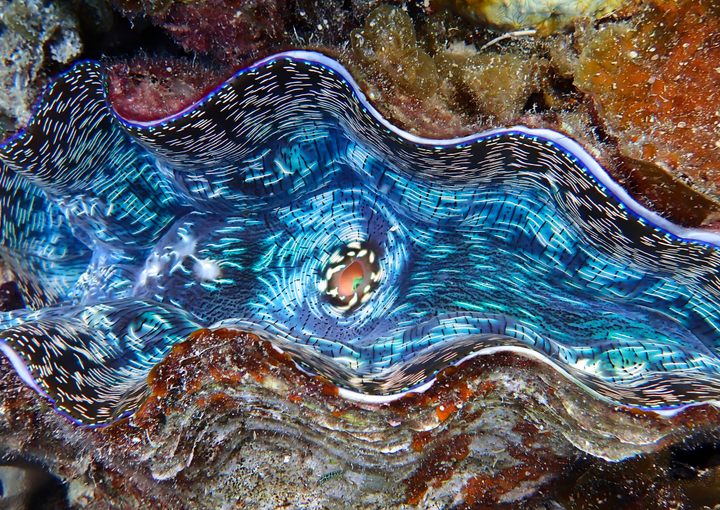
The History, Myth, and Future of the Giant Clam
Despite traditional and modern protections, Palau’s massive mollusks are at risk.
Excerpted from The Sound of the Sea: Seashells and the Fate of the Oceans. Copyright (c) 2021 by Cynthia Barnett. Used with permission of the publisher, W. W. Norton & Company, Inc. All rights reserved.
The islands of Palau in the western Pacific—hundreds of them, comprising one of the world’s smallest nations—have been inhabited for at least 3,400 years, and from the start, giant clams were a staple of diet, daily life, and even deity. Many of the islands’ oldest surviving tools are crafted of thick giant-clam shell: arched-blade adzes, fishhooks, gougers, heavy taro-root pounders. Giant-clam shell makes up more than three-fourths of some of the oldest shell middens in Palau—a percentage that decreases through the centuries.
Archaeologists suggest that the earliest islanders depleted the giant clams that crowded the crystalline shallows, then may have self-corrected. Ancient Palauan conservation law, known as bul, prohibited fishing during critical spawning periods, or when a species showed signs of overharvesting.

Before the Christianity that now dominates Palauan religion sailed in on 18th-century mission ships, the culture’s creation lore began with a giant clam called to life in an empty sea. The clam grew bigger and bigger until it sired Latmikaik, the mother of human children, who birthed them with the help of storms and ocean currents.
Pacific islanders put giant clams to practical use while also seeing in them a certain spirit. The shells served on some islands as ceremonial containers for ancestral skulls or ritual washing vessels. When Tridacna gigas—the world’s largest bivalve mollusk—were still little known in Europe, the first shells brought home by explorers were revered by collectors and kings, and made their way to Christian ritual as baptismal fonts.
In the early 16th century, the Republic of Venice presented King Francois I with what would become the most famous pair of giant-clam shells in church history. Two hundred years after the gift, the sculptor Jean-Baptiste Pigalle mounted the bowls on oceanic marble bases for holy water fonts in the Church of Saint-Sulpice in Paris, where they are still admired. Victor Hugo, who married in the church in 1822 with the help of a fake baptism certificate, would later donate two giant-clam fonts to Saint-Paul-Saint-Louis, the Baroque church in the Marais quarter of Paris, to mark the occasion of his daughter Leopoldine’s secret marriage there. Giant-clam fonts grace La Sagrada Familia Basilica in Barcelona, and now Catholic churches around the world, perhaps inspired by Pacific peoples’ infant bathtubs made of giant clams.

“Who would not feel cosmically heartened and strengthened imagining himself bathing in the shell?” the French philosopher Gaston Bachelard is said to have exclaimed over the prodigious basins.
Yet somehow, in the 19th-century macho mélange of exploration and deep-sea fantasy, a beloved icon of birth and renewal became maligned as a man-killing monster, its steely jaws poised to trap and drown luckless divers.
The scientific name Tridacna, from the Greek words tri (“three”) and dakno (“to bite”), was originally meant to describe not clams biting humans, but humans biting clams. Pliny the Elder explained in his Natural History: The expedition of Alexander revealed footlong oysters in the Indian Sea, and “some spendthrift and gourmand” named them tridacna, “wishing it to be understood thereby, that they are so large as to require three bites in eating them.”
But in the English-speaking world, “giant clam” was synonymous with “killer clam” for most of the 19th and 20th centuries. In German, it was the Mörder Muschel. All with no evidence—none historic, none popular, none scientific, not even an unverifiable but possible story—of anyone ever being killed in the grasp of a giant clam.
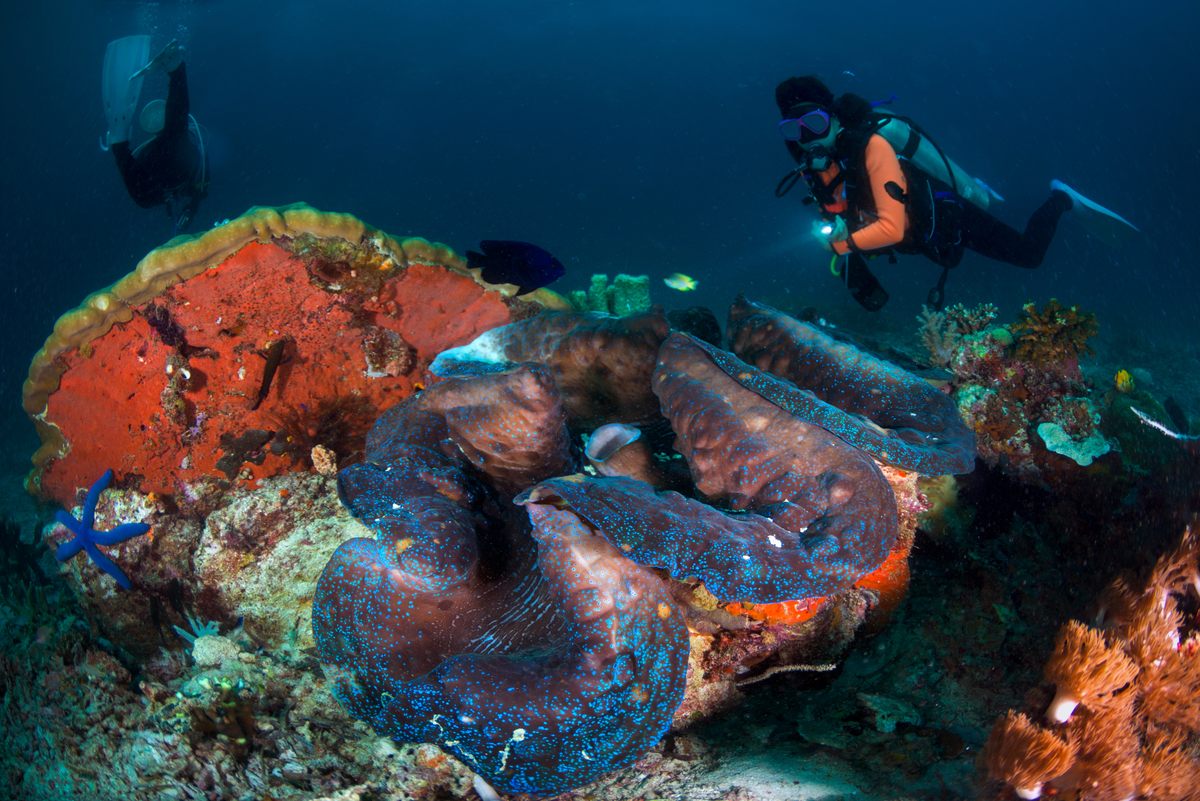
Perhaps long ago in Polynesia, a child got a foot caught while wading in the shallows among abundant giant clams, and parental warnings spun into lore. Or maybe a spear-fisher told a whopper to his pals, and it grew as fish tales do. In the Maori legend Rata’s Voyage, a stowaway on a canoe journey, Nganaoa, gets to stay aboard after proving his worth by killing first a giant clam that threatens to chomp down on the canoe, next an octopus that tries to drag the boat under the sea, and finally a whale about to swallow the whole party. In a macabre trickster tale told in various versions around Polynesia, a mouse-deer or a tortoise gets back at an ape by taking him clam-fishing and directing him to a gargantuan clam for its delicious meat. The ape reaches in and the mollusk cuts his hand clean off.
The legends reflect the human propensity to conjure grotesqueries of real animals. In the age of sea exploration in the 19th century, writers planted existential dread in dark grottos or at the ocean bottom—Verne’s fantasy of a supernatural sea. Verne set Twenty Thousand Leagues Under the Sea in a time when “there appeared in papers caricatures of every gigantic and imaginary creature, from the white whale, the terrible ‘Moby Dick,’ of hyperborean regions, to the immense kraken, whose tentacles could entangle a ship of five hundred tons and hurry it into the abyss of the ocean.”
The naturalists who observed giant clams firsthand in the tropical Pacific vividly described them with admiration as the eye-catchers of the reefs. Passing over a rainbow of clams in the Philippines, the English conchologist Hugh Cuming reported they were as colorful as “a beautiful bed of tulips.” But popular writers adding sellable zing to the science texts of the day hyped up the image of the man-eating—even shark-eating—giant clam.
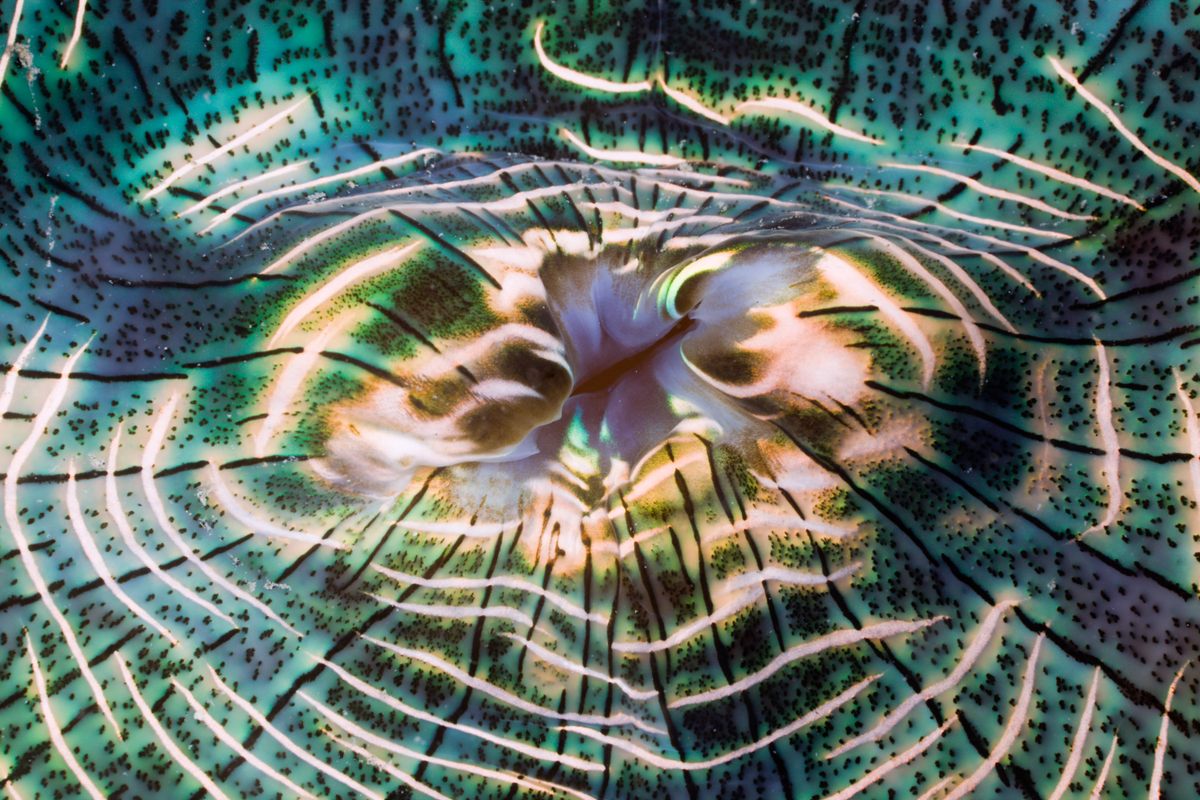
“So powerful are they that large sharks and rays that have accidentally crossed them have been seized and held,” warned the outdoors writer Charles Frederick Holder in his 1885 Elements of Zoology, a collaboration with his zoologist-physician father Joseph Holder.
In the 1920s, Popular Mechanics reported that in Papua, “Divers who accidentally step into the open lips of the monsters are not infrequently held with such force that they cannot release themselves and are drowned. The shells close with such force that they serve as gigantic traps.” In the ’30s, the New York Times Sunday travel section weighed in on the “nightmare bivalve of the Australian seas.” Exaggerating its size—“often described” as 14 feet long—and danger, the newspaper of record reported that its snapping shell “has caused the deaths of many natives and divers who have been caught by the foot and found themselves unable to wrench free.”
The stories captured the imagination of the U.S. Navy during World War II, when soldiers fighting in the Pacific were briefed on the “man-eating clams” and large sharks known to inhabit the reefs. The man-eater myth was so persistent that decades later, Navy diving manuals still advised frogmen how to free themselves if caught in the “vise-like” grip of a giant clam: by inserting a knife between the valves and severing the animal’s adductor muscle.
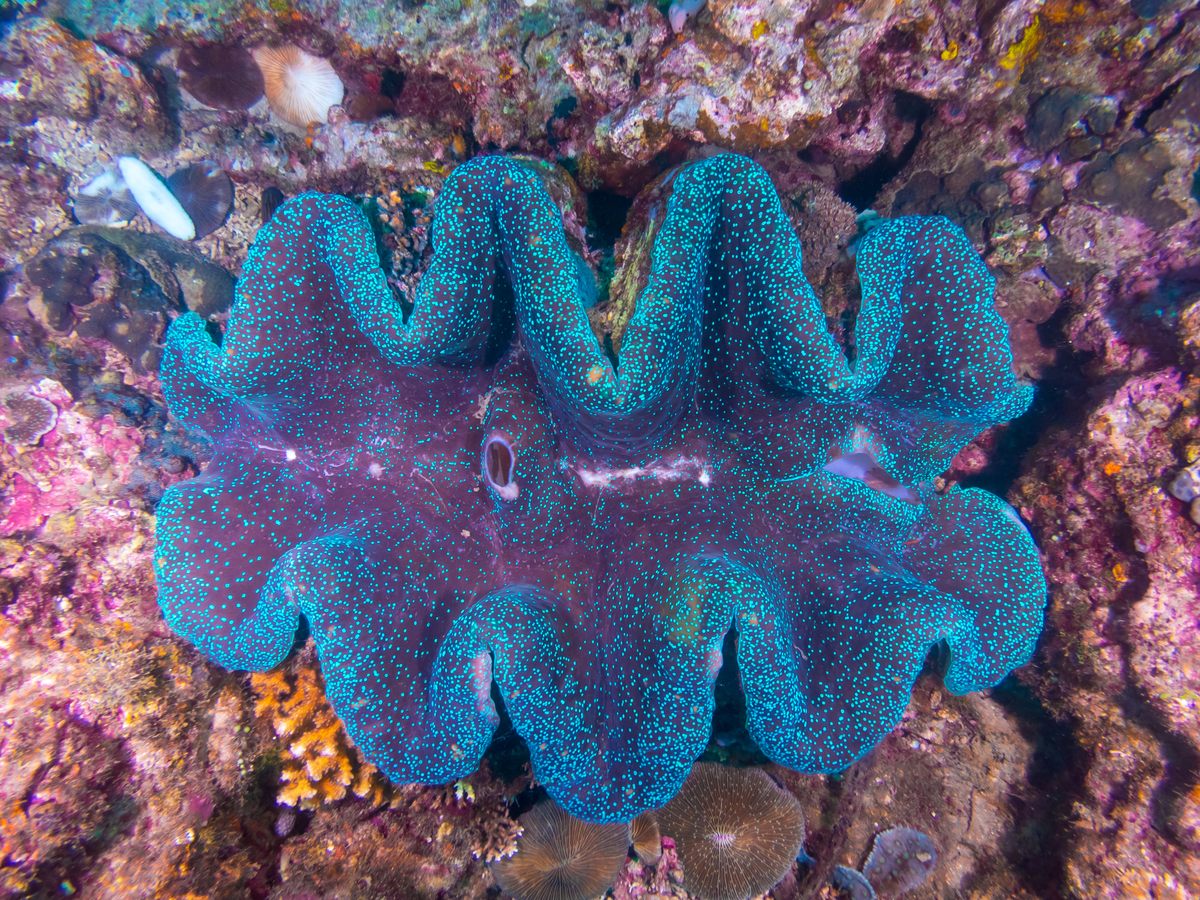
Even the pioneering marine biologist Eugenie Clark, who did perhaps more than any other scientist to dispel myths about sharks, was gripped by the trope. During a trip to Palau in the early 1950s, Clark profiled one of her guides, the tall and muscular spear-fisher Siakong, who, when he took off his work clothes to dive into the sea in his red loincloth, “suddenly metamorphosed from a bum into a statue of a Greek god.”
The two were spear-fishing in the rain one afternoon when Siakong called, “Nechan (‘big sister’), come see!” Clark dove down and saw a T. gigas so huge that it “could have held all of Siakong with ease.” Unable to lift the clam, Siakong dove to extract the meat for a reef picnic. When he failed to surface, Clark dove again to find a sight “that sickened me with horror. Siakong was caught in the clam!”
The jaws of the gigantic mollusk were clamped tight, with Siakong’s arm inside up to the elbow. He wasn’t moving. As Clark panicked, rose for air, and tried to figure out how to save Siakong from drowning, he surfaced with a grin and held up the largest clam muscle she’d ever seen. Saikong had been deep in the clam, sawing through its adductor muscle with his knife. Clark recovered from the joke, and they shared a raw hunk of clam the size of a man’s thigh.
Even as scientists began to discover the giant clam’s role in coral-reef ecosystems in the 1960s, its popular image as killer clam endured, from television shows to roadside attractions. In the 1975 Doctor Who serial Genesis of the Daleks, the doctor is attacked by the cheesiest giant clams of all time while trying to stop mad scientist Davros from doing horrific experiments. To this day along Interstate 75 through Michigan, billboards remind tourists bound for Mackinac country to take Exit 326 to see the “Man-Killing Giant Clam” at Sea Shell City in Cheboygan.

Like the bloodthirsty shark, the conniving wolf, and the evil snake, the mythos of the killer clam was born out of fear of the unknown and grew incongruously more menacing the more humanity came to know, and then dominate, the sea. All the while the giant clams, like every pair of shells in the ocean, held their truths about life and survival.
Giant clams are a beloved staple in Palau and in many parts of the Pacific. They’re eaten raw with lemon, simmered in coconut milk for a buttery soup, baked into a savory pancake, or sliced and sautéed. In old times, they were known as “stormy-weather food,” the fresh staple that was easy to collect and have on hand when it was too stormy to go out fishing. But like the abalone off the coast of California, wild scallops along the eastern seaboard, and the oysters of the world, an Indigenous staple became a delicacy and soon an expensive trophy, won in an unfair hunt. In the 1960s, Chinese and Taiwanese clam boats began to range farther and farther into the Pacific Islands, the Indo-Malay region, and Australia’s Great Barrier Reef to collect the coveted adductor muscles that pull the clams’ two shells together. The muscle, favored in sashimi and an alleged aphrodisiac, accounts for only about 10 percent of the animal’s flesh, but the fishers often left the remaining meat to rot.
Luxury demand for the adductor and the ivory-like shells has driven T. gigas extinct in China, Taiwan, and other parts of their native habitat. Some of the toughest marine protection laws in the world, along with giant-clam aquaculture pioneered here, have helped Palau’s wild clams survive. The Palau Mariculture Demonstration Center raises hundreds of thousands of giant clams a year, supplying local clam farmers who sell to restaurants and the aquarium trade and keeping pressure off the wild population. But as other nations have wiped out their clams, Palau’s ocean territory is an increasing target of illegal fishers.

Scientists estimate poachers illegally hauled in up to half a million clams a year for four decades before international pressure and prosecutions slowed them down. During a crackdown in Palau in the 1980s, a police team seized an illegal Taiwanese fishing boat loaded with 7,500 pounds of pure adductor muscle. While the officers were unloading the meat, Palau’s tribal chief reported, the poachers tried to bribe him to look the other way.
Giant clams’ shells have become as valuable as their meat. The rippled bowls once used as infant bathtubs are now in demand for poolside fountains and bathroom sinks in seaside homes. Giant clamshells have long been venerated in China, especially by followers of Buddhism, who count them among the seven treasures of nature.
In a fishing port called Tanmen in the resort province of Hainan Island overlooking the South China Sea, fishers and artisans made fortunes mining giant-clam shells and turning them into Buddhist prayer beads and elaborate animal sculptures believed to bring good luck and prosperity. White-shining elephants, fat toads, and arowana fish carved from the ivory-thick shells packed the shelves of some 900 retailers in the town by 2015, when fishers could pull in 80,000 yuan, or $12,000, for a single T. gigas.

In the end the charms were not so lucky for the fishers, crafters, and retailers who depleted the clams and destroyed their habitat. Demand for the figurines sent crews to smash coral reefs with their boat propellers to free up anchored clams, decimating miles of some of Earth’s most biodiverse coral reefs in the South China Sea. International outcry ultimately led Hainan Province to ban trade in giant clams and corals. The Tanmen workshops and retail shops have shuttered en masse. The clams may never recover.
Giant clams were once spread so thickly along the shallow coasts and coral reefs of the tropical Pacific that the conchologist Cuming described drifting over a solid mile of them on a collecting trip. The clams settle in clusters because they need to be close to each other to reproduce; they spawn in sync. Mature clams generate both sperm and eggs and release them into the water from their siphons like smoke from a little stovepipe, setting off a chain of fertilization.
Yet not two centuries after Cuming reported sea bottom carpeted with giant clams, they are now spread too thinly in much of their native habitat to fertilize. A single T. gigas can send as many as 500 eggs into the ocean in one spawning. Alas, fecundity is no consolation in a lonely sea.
Palau has created one of the largest areas of protected ocean in the world. Its 193,000-square-mile ocean sanctuary is the size of California, yet it owns just two marine patrol boats. In 2012, two Palauan marine officers and their American pilot crashed while searching by air for the Chinese mother ship of a fishing fleet that had stolen giant clams from enormous Helen Reef in Palau’s far southwestern state of Hatohobei. The pilot and officers were never seen again. The clams were dumped by fleeing poachers. The stolen clams must have tumbled like boulders into the open ocean, down into a deeper sea than they had known.



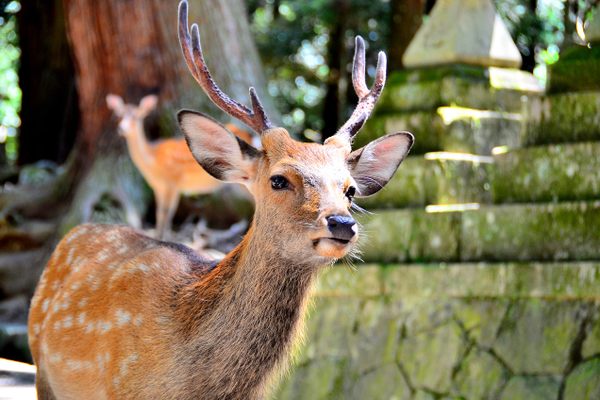
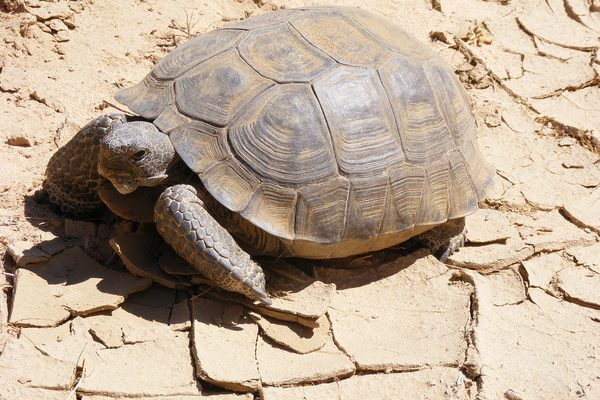






















Follow us on Twitter to get the latest on the world's hidden wonders.
Like us on Facebook to get the latest on the world's hidden wonders.
Follow us on Twitter Like us on Facebook